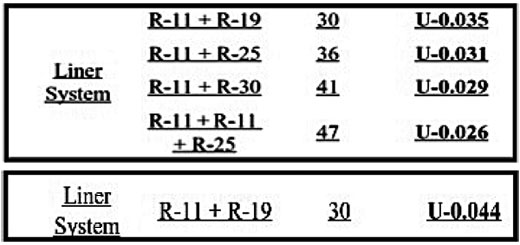Ensuring commercial energy code compliance: A breakdown of the prescriptive assemblies from the 2012 IECC
If you missed part 1 of my “Top Takeaways” blog post, you can read it here.
 Now that we’ve covered the introductory basics on differentiating between IECC and ASHRAE, as well as the information contained in a commercial energy code, we can move on to ensuring that you understand how to meet your state’s latest energy code. The key to compliance is in the prescriptive roof and wall assemblies.
Now that we’ve covered the introductory basics on differentiating between IECC and ASHRAE, as well as the information contained in a commercial energy code, we can move on to ensuring that you understand how to meet your state’s latest energy code. The key to compliance is in the prescriptive roof and wall assemblies.
Takeaway #4: What to Know to Ensure Compliance:
The 2012 IECC Prescriptive Assemblies
Zone 4 walls = R13 ci (Board/Thermax™) + R13 Fiberglass OR U-Factor of 0.052 (installed R-Value of 19.2)
Other options:
- OptiLiner™ (Liner System) R30 (9” fiberglass) and foam tape = U-Factor of 0.049
- Insulation board (thickness dependent on R-Value per inch)
- Insulated panel (thickness dependent on R-Value per inch)
Zone 4 Roof = R19 + R11 Liner System with thermal block OR U-Factor of 0.035 (Installed R-Value of 28.6)
Other options:
-
- Long Tab Banding (filled cavity) R25 + R19 with thermal block = U-Factor of 0.029
- Insulation board or insulated panels (thickness dependent on R-Value per inch)
Takeaway #5: Metal Building Assembly Descriptions
Now that you know where to find the prescriptive assemblies, let’s take a closer look at the most common system used to meet the wall and roof assemblies.
Liner System: Walls
NOTE: Liner System wall testing performed by Owens Corning and can be used for code compliance. Values are NOT found in ASHRAE tables.
It’s important to understand that the wall values as described in the IECC 2012 code are suggested methods to meet the U-Value for that climate zone (i.e. R-13 plus R-13 Continuous). The overall U-Value for this combination is U-0.052. Most builders do not realize that any system Hot Box tested with a U-Value equal to or better than any climate zone U-Value is also allowed. This information can be found in Chapter 4 section C402.1.2 of the IECC 2012 Code.
Liner System: Roof
My most frequently stated tip for better understanding prescriptive roof assemblies is to remember that the assemblies assume a standing seam roof with a thermal block is used. Though it’s fairly straightforward, builders often forget about this underlying assumption.
I hope you’ve found these top takeaways from my MBCEA presentation helpful. Check back in September, when I’ll cover the basics of COMcheck™, which is a widely used tool that helps builders meet the requirements of the IECC and ASHRAE Standard 90.1, as well as several state-specific codes.
Want to make sure you don’t miss out on the latest energy code updates?
Subscribe to our energy code newsletter to get blog posts sent directly to your inbox.
MORE BLOGS
IECC 2015 And ASHRAE 90.1-2013: What You Need To Know
The next commercial energy code cycle for most states is the IECC 2015 code and ASHRAE 90.1-2013 alternative path.
Your Top Air Barrier Questions Answered + MaxTight™
Answering Your Questions, Plus Our New Air Barrier System
A Closer Look at Air Barriers:
What are the new air barrier requirements? Find out in this post.
Commercial Energy Codes Update for 2016
Let’s take a look at the top commercial energy code updates you should know for 2016.
5 Commercial Building Insulation Retrofit Facts To Know
Insulation retrofits in metal buildings: What you need to know.
Air Barrier Requirements for Commercial Code Compliance
Air barriers for metal buildings: A primer.
The Code Man Talks Compliance for Fenestrations
Doors, windows, and skylights, oh my! Let’s talk compliance for fenestrations.
Commercial Energy Code Changes Throughout 2014
There’s a new ASHRAE Standard and IECC Code: Let’s get into it.



